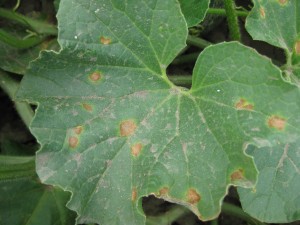 We are just now finding powdery mildew on squash and pumpkins, several weeks later in the season than we have seen it during the past few years. So far disease incidence and severity have been relatively low in commercial fields, as well as in OSU research plots. The fungus that causes cucurbit powdery mildew does not overwinter in Ohio, so the disease does not appear until spores arrive on wind currents from warmer growing areas. This fungus is an unusual plant pathogen in that it is inhibited by free water – so the frequent rains we have been experiencing may have kept this disease at bay for the time being. However, it is here now and will undoubtedly flare up in susceptible cucurbits unless they are treated with fungicides. Signs of infection are small circular powdery growths (mycelium and spores of the pathogen) on either side of the leaf. These spots enlarge and can eventually cover most of the leaf surface and kill the leaves. Stems and leaf petioles are also susceptible, but the disease is not observed on fruit. In pumpkins, powdery mildew may also attack the “handles”, which can be further damaged by secondary pathogens.
We are just now finding powdery mildew on squash and pumpkins, several weeks later in the season than we have seen it during the past few years. So far disease incidence and severity have been relatively low in commercial fields, as well as in OSU research plots. The fungus that causes cucurbit powdery mildew does not overwinter in Ohio, so the disease does not appear until spores arrive on wind currents from warmer growing areas. This fungus is an unusual plant pathogen in that it is inhibited by free water – so the frequent rains we have been experiencing may have kept this disease at bay for the time being. However, it is here now and will undoubtedly flare up in susceptible cucurbits unless they are treated with fungicides. Signs of infection are small circular powdery growths (mycelium and spores of the pathogen) on either side of the leaf. These spots enlarge and can eventually cover most of the leaf surface and kill the leaves. Stems and leaf petioles are also susceptible, but the disease is not observed on fruit. In pumpkins, powdery mildew may also attack the “handles”, which can be further damaged by secondary pathogens.
Powdery mildew is managed using powdery mildew-resistant varieties and fungicides. Development of insensitivity to overused fungicides is common in populations of the fungus that causes this disease, so it is important that a fungicide resistance management program is followed. Remember to alternate fungicides in different FRAC (Fungicide Resistance Action Committee) groups, indicating different modes of action against the fungus. It is important to apply fungicides when the disease first appears and incidence is low. Fungicides that are effective against cucurbit powdery mildew can be found in the Midwest Vegetable Production Guide for Commercial Growers; product ratings are on page 117. Our evaluations of efficacy of powdery mildew fungicides at three locations (Wooster, Columbus, South Charleston) in Ohio in 2016 indicated that five products consistently provided very good control (> 93%) of powdery mildew on pumpkins in all three locations (see table). Three products were very good in Wooster and Columbus but fair in South Charleston; control by Fontelis was 73% in South Charleston, while the others provided less than 55% control at that location. Both Bravo and Pristine performed poorly in all three locations.










